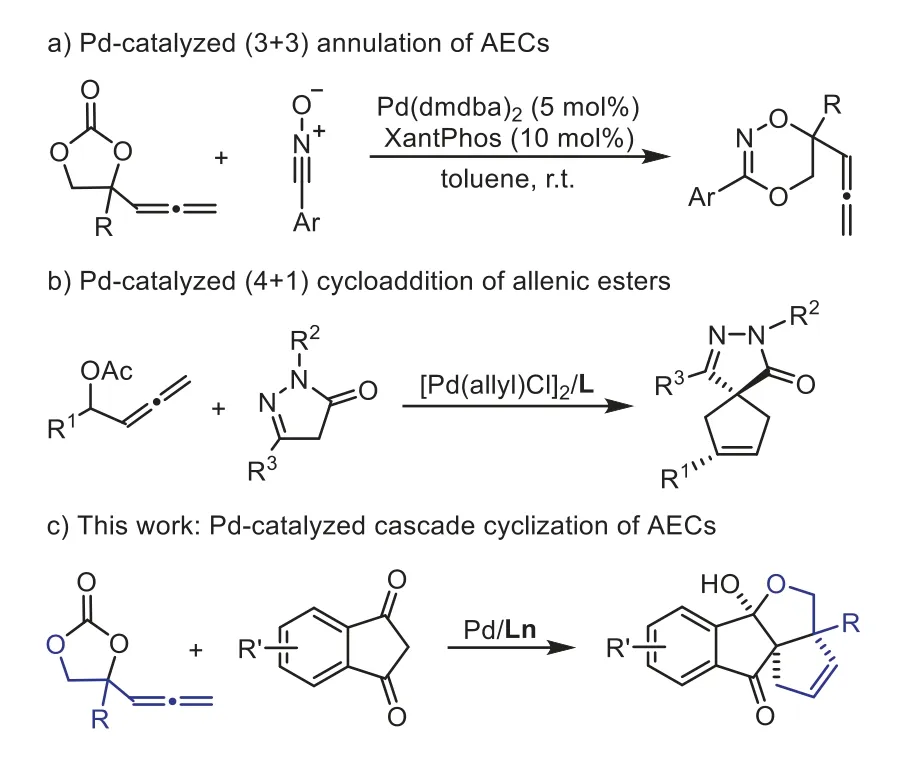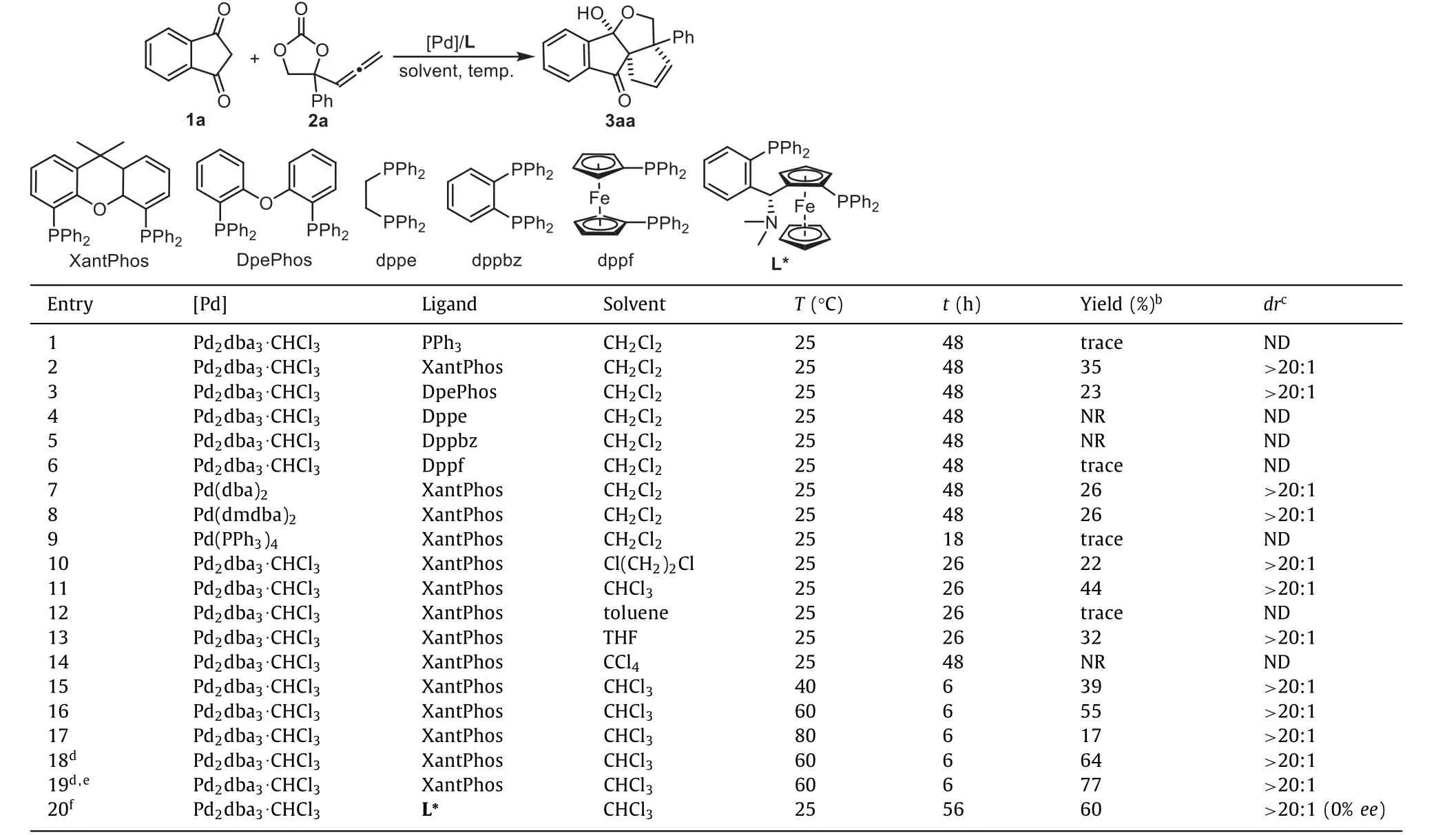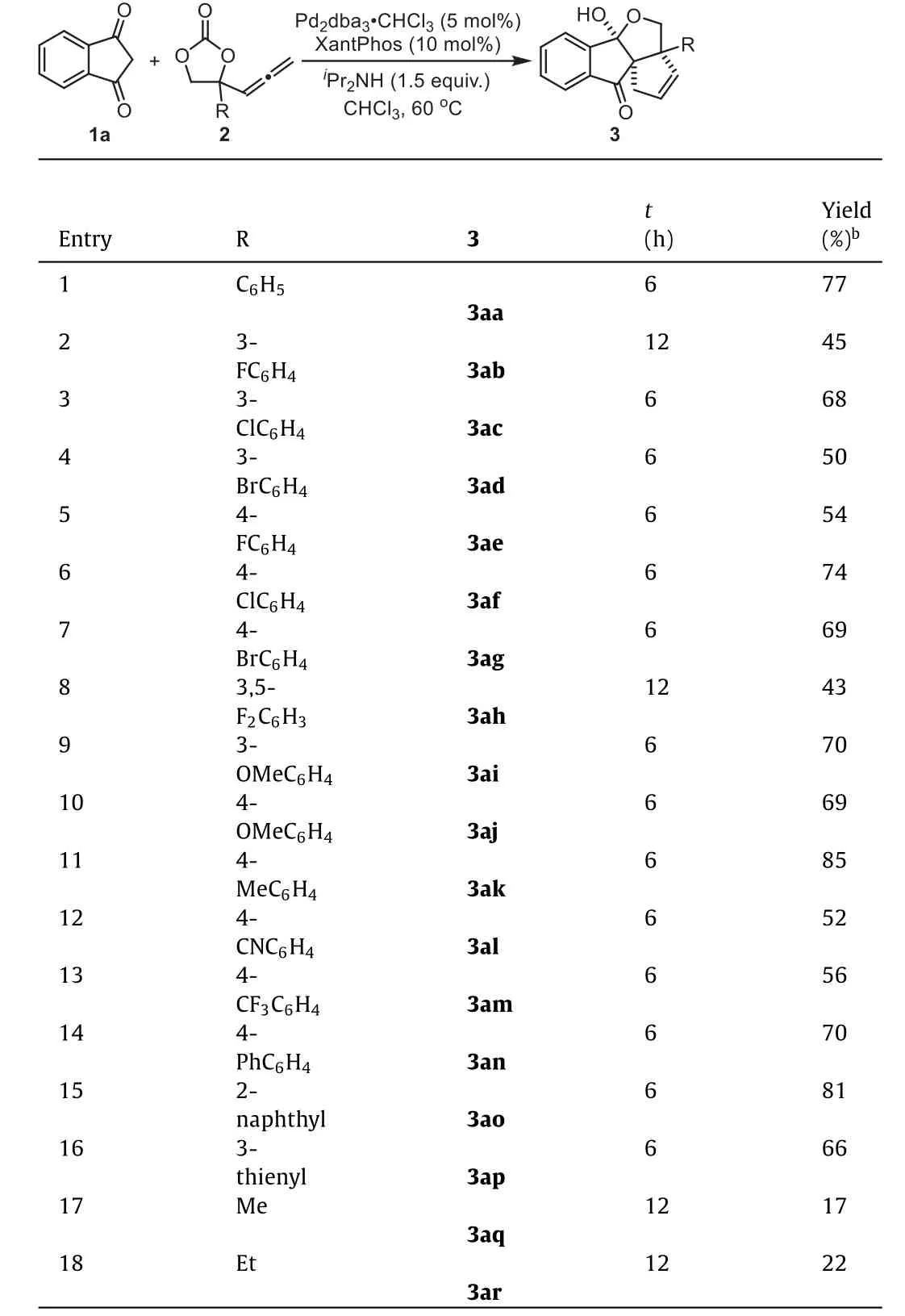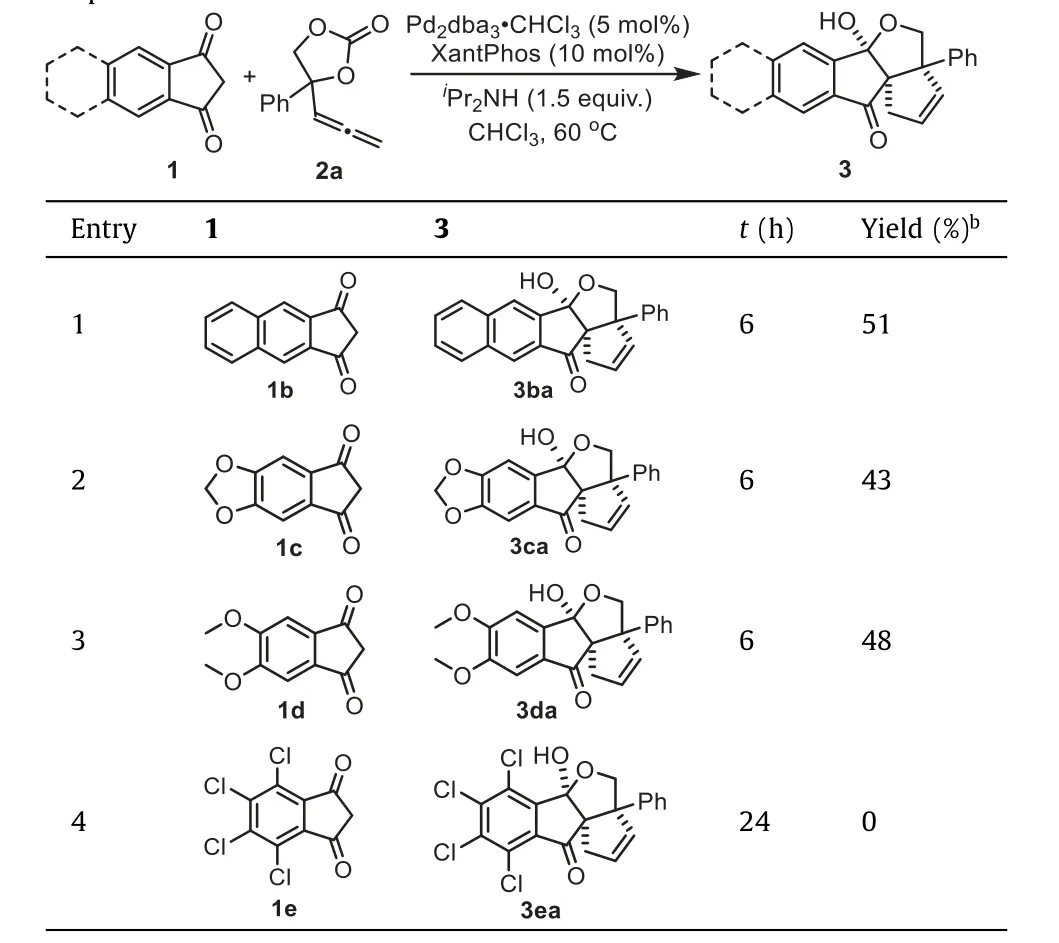Pd-catalyzed cascade cyclization of allenylethylene carbonates and indandiones: Synthesis of tetracyclic dihydrocyclopentaindenofuranone derivatives✩
Yujie Dong, Jun Liu, Xing Go, Ting Pn, Biming Mo, Songcheng Yu, Yongjun Wu,Cheng Zhng,*, Hongcho Guo,*
a Department of Chemistry and Innovation Center of Pesticide Research, China Agricultural University, Beijing 100193, China
b College of Public Health, Zhengzhou University, Zhengzhou 450001, China
Keywords:Palladium Allenylethylene carbonates Indandiones Cascade cyclization Decarboxylation
ABSTRACT A palladium-catalyzed cascade cyclization of allenylethylene carbonates with 1,3-indandiones was developed, providing biologically interesting tetracyclic dihydrocyclopentaindenofuranone derivatives having three contiguous quaternary carbon centers in moderate to high yields with excellent diastereoselectivities.In this reaction, the allene moiety was fully fused into the cyclopentene ring.
Terpenoids such as Ginkgolides and Bilobalide (Fig.1) are unique components of the Ginkgo biloba tree, which displayed diverse bioactivities such as antioxidant, anti-aging, blood pressure lowering, blood circulation promotion and anti-platelet activating factors [1–4].Therefore, synthesis of Ginkgolides, Bilobalide and their derivatives having multicyclic skeleton are very significant and have attracted much attention [5].However, assembly of contiguous quaternary carbons in these terpenoid natural products remains a big challenge.New synthetic methods for these structures are highly desirable.
Pd-catalyzed decarboxylative cycloadditions are one of the most powerful tools for synthesis of carbo- and hetero-cyclic compounds from readily available starting material [6–20].Generally, these(m+n) cycloadditions were furnished through stepwise reactions of in situ generated zwitterionicπ-allyl palladium intermediates from decarboxylation of precursors with electron-deficient reaction partner [6–20].Obviously, the type and reactivity of the precursors for formation ofπ-allyl palladium intermediate played a key role in Pd-catalyzed decarboxylative cycloadditions.In 2021,we designed and synthesized the allenylethylene carbonates (AECs)as the precursor ofπ-allyl palladium intermediates, which may act as 1,3 or 1,5-dipoles undergoing cycloadditions with dipolarophiles [21].In our early exploration, we studied the cycloaddition reactions of AECs with electron-deficient reaction partner and successfully developed a palladium-catalyzed (3+3) annulation of AECs with nitrile oxides, producing 3,6-disubstituted-5-hydro-1,4,2-dioxazines in high yields (Scheme 1a) [21].In this example, AECs worked as three-membered synthons and the allene moiety in AECs did not participate in the construction of sixmembered ring.As continuous efforts in the exploration on the application of AECs in Pd-catalyzed cycloadditions, we anticipated to achieve formation of ring system involving the allenyl moiety.In 2019, Shao reported an elegant Pd-catalyzed (4+1) cycloaddition of allenyl acetates and pyrazolones, in which allenic esters worked as C4 synthons to be fused in cyclopentene rings (Scheme 1b) [22].This inspired us to think about transformations of allene moiety of AECs for construction of cyclic framework.The 1,3-indandiones were often used in cascade/domino reactions to construct various cyclic compounds because the protons of methylene group are very acidic and prone to isomerize into their enol forms [23,24].Considering the high reactivity of 1,3-indandiones,we explored their reaction with AECs under palladium catalysis.Herein we report palladium-catalyzed cascade cyclization of AECs with 1,3-indandiones, giving tetracyclic dihydrocyclopentaindenofuranone derivatives having three contiguous quaternary carbon centers (Scheme 1c).

Fig.1.Terpenoid natural products.

Fig.2.X-ray crystal structure of the product 3af.

Scheme 1.Pd-catalyzed decarboxylative annulations of AECs.
We chose the reaction of 1,3-indandione1aand AEC2ato begin the investigation (Table 1), which was performed in CH2Cl2at 25°C.When the combination of Pd2dba3·CHCl3with PPh3was used,no product was observed (Table 1, entry 1).We then screened a series of ligands (entries 2-6) and found that when XantPhos was used as the ligand, and the desired product3aawas isolated in the highest 35% yield (entry 2).Subsequently, with XantPhos as the ligand, different palladium catalysts were tested and no bet-ter yield was obtained (entries 7-9).We then screened several other solvents, including ClCH2CH2Cl (DCE), CHCl3, toluene, THF and CCl4(entries 10-14).Among them, CHCl3exhibited the best performance, and the product3aawas obtained in 44% yield (entry 11).Effect of temperature to the reaction was also investigated(entries 15-17).The reaction at 60 °C led to the product in 55%yield (entry 16).During the optimization process, we found that the AEC underwent self-polymerization to form side products, so that we increased the loading amount of AEC and the yield of3aawas thus increased to 64% (entry 18).In further optimization, various bases were examined as additives (detailed in Supporting information).To our great delight, when diisopropylethylamine was used as the base, the yield of product3aawas improved to 77%(entry 19).In order to develop asymmetric catalytic reaction, we screened various types of chiral ligands (see Supporting information for details).Unfortunately, only chiral ligandL*displayed catalytic activity, delivering the product in 60% yield but with 0%ee(entry 20).

Table 1 Optimization of reaction conditions.a

Table 2 Scope of allenylethylene carbonates.a

Table 3 Scope of indandiones.a
Having established the optimal conditions, we tested a variety of AECs to explore the reaction scope.The results were summarized in Table 2.The reactions of AECs2bearing diverse substituents with different electronic properties with 1,3-indandione1awere carried out under standard conditions (entries 1-18).The AECs with halogen atoms at themetaorparaposition of the phenyl group were tolerated, producing the desired products (3ab-3ah) in 43%-74% yield (entries 2-8).The AECs having electron-donating (Me and OMe) and electron-withdrawing (CN and CF3) groups on the phenyl ring at themetaandparaposition were also favourable (entries 9-13), and the corresponding products were obtained in 52%-85% yields.The AECs with biphenyl moieties also performed well in the reaction, leading to the formation of the corresponding product3anin 70% yield (entry 14).In addition, AECs containing fused or heterocyclic aromatic groups were also suitable substrates.The AEC containing a 2-naphthyl group afforded the corresponding product3anin 81% yield (entry 15) while the 3-thienyl substituted one afforded the corresponding product3apin 66% yield (entry 16).Unfortunately, the AECs containing methyl and ethyl groups were challenging substrates, affording the corresponding products3aqand3arin poor 17% and 22% yield respectively (entries 17 and 18).The structure of the product3afwas confirmed by the results of single crystal X-ray diffraction analysis (Fig.2, CCDC 2,195,449, detailed in Supporting information).
We further evaluated various 1,3-indandione in this cascade cyclization of AECs2a.As indicated in Table 3, the effect of different substituents on the phenyl group of indandione1was tested.Delightedly, 1H-cyclopenta[b]naphthalene-1,3(2H)–dione (1b) was workable, producing the product (3ba) in 51% yield (entry 1).The reaction of 1,3-indandione1chaving dioxolane moiety on the benzene ring resulted in the formation of the corresponding product3cain 43% yield (entry 2).The reactivity of 5,6-dimethoxy-1Hindene-1,3(2H)–dione (1c) was moderate, giving 48% yield of the product3 da(entry 3).Unfortunately, the 4,5,6,7-tetrachcloro-1,3-indene–dione (1e) did not work (entry 4).The big steric hindrance may suppress the reaction.
In order to demonstrate the practical applicability of this reaction, we carried out a scale-up reaction under standard reaction conditions (Scheme 2).This cyclization reaction at 2 mmol of scale still proceeded smoothly to give the product3aain 65% yield.Subsequently, the transformation of product3aawas conducted.As catalytic cycle could proceed without needing a base.Therefore,the role ofiPr2NH probably was to assist deprotonation.

Scheme 2.Scale-up reaction and further transformation of the product.
In summary, we have developed a palladium-catalyzed cascade cyclization of allenylethylene carbonates with 1,3-indandiones.Under the standard conditions, a variety of AECs worked well with indandiones, producing biologically interesting tetracyclic dihydrocyclopentaindenofuranone derivatives having three contiguous quaternary carbon centers in moderate to high yields with excellent diastereoselectivities.Additionally, the scale-up reaction and latestage transformations of the product3aawere also demonstrated.In this reaction, the allene moiety of AECs was fused into the ring system for the first time.The cascade cyclization reaction indicates that AECs may work as a versatile synthon and find more applications in construction of ring system.shown in Scheme 2, under the catalysis of palladium, the product

Scheme 3.A plausible reaction mechanism.
3aawas reduced by hydrogen to form the product4in 78% yield(CCDC: 2195450, detailed in Supporting information).The double bond of3aaunderwent addition reaction with Br2to afford the corresponding product5in a yield of 75% (CCDC: 2195452, detailed in Supporting information).In the presence of Et3N, the hydroxyl in the product3aareacted with 3,5-dinitrobenzoyl chloride to form the product6.
As shown in Scheme 3, a plausible reaction mechanism was proposed.In the presence of palladium catalyst, decarboxylation of AEC2aafforded the zwitterionic intermediateA, which subsequently deprotonated the 1,3-indandione1ato produce both the reaction partnersBandC.They performed allenylic alkylation to produce the intermediateD.Subsequent isomerization generated the intermediateE, which perform hemiacetalization/intramolecular cyclization to produce the product3aawith regeneration of the catalyst.According to the data in Table 1, the
Declaration of competing interest
The authors declare that they have no known competing financial interests or personal relationships that could have appeared to influence the work reported in this paper.
Acknowledgment
This work is supported by the Natural Science Foundation of China (Nos.21871293 and 22071264).
Supplementary materials
Supplementary material associated with this article can be found, in the online version, at doi:10.1016/j.cclet.2023.108297.
 Chinese Chemical Letters2023年10期
Chinese Chemical Letters2023年10期
- Chinese Chemical Letters的其它文章
- Tribute text in memoriam of James N.Seiber (1940–2023)
- Recent advances in MXenes-based glucose biosensors
- Oxidative cyclopalladation triggers the hydroalkylation of alkynes✩
- An integrated supramolecular fungicide nanoplatform based on pH-sensitive metal–organic frameworks
- Probing the effect of nitrate anion in CAN: An additional opportunity to reduce the catalyst loading for aerobic oxidations✩
- Nickel-catalyzed reductive coupling reaction of monofluoroalkyl triflates with alkyl carboxylic acids toward the synthesis of α-alkyl-α-fluoro-alkylketones✩
